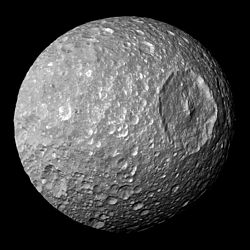Wikijunior:Solar System/Saturn/Mimas

Mimas is one of the moons of Saturn.
How big is Mimas?
[edit | edit source]Mimas is 397.2 km wide (246 miles). It is egg shaped because Saturn and the other moons stretch it with their gravity.
What is its surface like?
[edit | edit source]The surface of Mimas is covered with craters, the largest being Herschel, which was named after William Herschel, the person who discovered Mimas. This crater is about one-third of Mimas' width. It is 5 km (3 miles) high, 10 km (6 miles) deep, and its peak is 6km (4 miles) above the crater floor. Mimas and Rhea, another of Saturn's moons, have been called the most heavily cratered bodies in the Solar System.
Mimas also has many chasmata (chasms), which are long, narrow, steep-sided depressions on the moon's surface.
How long is a day on Mimas?
[edit | edit source]One day on Mimas is equal to 23 hours.
How long is its orbit around Saturn?
[edit | edit source]Mimas takes 23 hours to make one orbit around Saturn. It has synchronous rotation, which means that it takes the same amount of time for Mimas to complete one orbit as it does for one rotation. The same side of Mimas is always facing toward Saturn.
What is it made of?
[edit | edit source]Mimas is made mostly of ice, with some rock. Mimas appears to be frozen solid despite its location to Saturn. This location should have made Mimas more susceptible to tidal heating from Saturn, thus causing partial thaw of the frozen ice.
How much would Mimas' gravity pull on me?
[edit | edit source]If you were on Mimas, the gravity would be 0.008 times as much as Earth's gravity.
Who is it named after?
[edit | edit source]Mimas is named after Mimas, the son of the Greek goddess Gaia. The named was suggested by John Herschel, William Herschel's son. Mimas is also called Saturn I.
How was it discovered?
[edit | edit source]Mimas was discovered in 1789 by William Herschel using a telescope. It was the second moon of Saturn to be discovered by Herschel
